Growing tomatillos is fairly easy, and they’re a very highly productive vegetable.
In this post you’ll learn what care to provide through the different tomatillo plant growing stages, so you can have the healthiest crops and the biggest harvests.
Find out how to plant tomatillos, what light, soil, and sun conditions they need to thrive, how to harvest them, and much more in our complete tomatillo care guide.
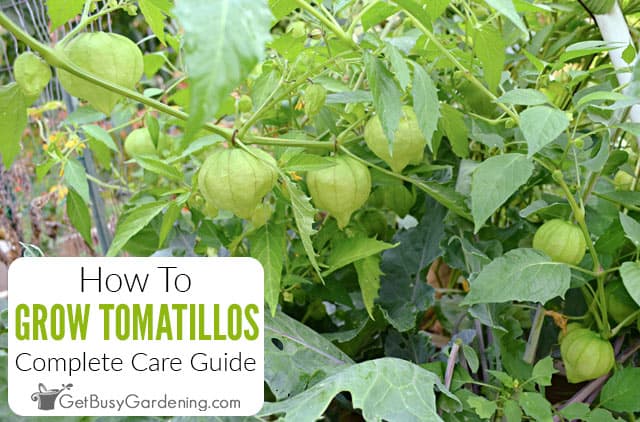
Quick Tomatillo Plant Care Overview
| Scientific name: | Physalis philadelphica |
| Classification: | Vegetable |
| Common names: | Tomatillo, Mexican Husk Tomato |
| Hardiness: | Zones 10-11 |
| Temperature: | 60-85°F (15-29°C) |
| Flowers: | Yellow, blooms summer through fall |
| Light: | Full sun |
| Water: | Keep soil evenly moist, do not overwater |
| Humidity: | Low-Average |
| Fertilizer: | High phosphorus and potassium granular fertilizer spring through fall |
| Soil: | Rich, fertile, well-draining |
| Common pests: | Flea beetles, aphids, slugs, snails, potato beetles, leafminers, cucumber beetles, root knot nematodes |
What Is A Tomatillo Plant?
Tomatillos (Physalis philadelphica) are members of the nightshade, or Solanaceae, family that includes other garden favorites like tomatoes, peppers, and eggplants.
They’re a fruiting plant with a thick central stem, many branches, and oval green leaves that end in a point.
Depending on the variety, tomatillos may sprawl or grow more upright. The plants average between 3-4’ in height.
Yellow flowers develop into a green, globular husk when pollinated. Eventually green tomato-like fruits grow to fill the husks.
The fruits are crisp, slightly firm, and have a tart-sweet flavor that’s slightly more acidic than tomatoes.
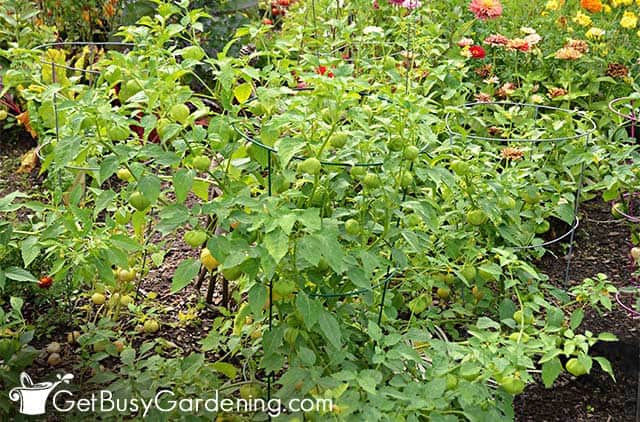
Different Types Of Tomatillos
There are many types of tomatillos to choose for your home garden. They differ in growth habits and fruit color, but all varieties require the same basic care to thrive.
A few of the more common options are:
- Toma Verde – This common husk tomato variety produces familiar green, golf-ball sized fruits that mature earlier than other options.
- Purple de Milpa – These small tomatillos have a purple hue and are known for their sharper flavor and long storage ability.
- Grande Rio Verde – The determinate nature of this variety requires no staking and produces large, bright green fruits.
Hardiness
Tomatillos are not cold hardy plants. They prefer warm temperatures above 60°F (15°C) and are very sensitive to cold and frost.
Though they are technically perennials in zones 10-11, most people grow them as annuals, replanting them every year.
How Do Tomatillos Grow?
Tomatillos grow from pollinated flowers that bloom on long pliable branches. They’re not self-pollinating and need a second plant to produce fruit.
The flowers require either insect or hand pollination between two or more plants for fruit to set.
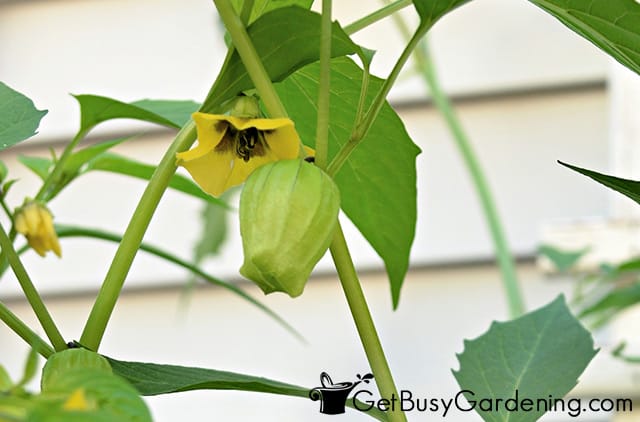
How To Grow Tomatillos
Before we get into the details of caring for your Mexican husk tomato plants, first we need to chat about when and where they’ll thrive. Use these tips to choose the perfect location and time to get them started.
Where To Grow Tomatillos
Tomatillo plants grow best in a location with plenty of sun and warmth. Some varieties grow upright while others sprawl, but all types need plenty of space for air circulation.
The branches become heavy with fruit, so support them with a plant cage or stakes to keep them off the ground.
Grow them in fertile soil either in your garden or a large pot. Containers need to be at least 5 gallons with drainage holes in the bottom to prevent overwatering.
When To Plant Tomatillos
Tomatillo plants take a long time to develop mature fruits. For those in cool climates I recommend starting them indoors 4-6 weeks before your last frost date.
If you live in a warm region with a long growing season, directly sow them when the last chance of frost has passed in the spring.
Much like tomatoes, tomatillos benefit from deep planting. Nestle the stems of your starts into the soil all the way up to the first true leaves to help them develop a deeper root system.
Read my guide on growing tomatillos from seed for more tips and step by step instructions for planting them.
How Long Do Tomatillos Take To Grow?
Tomatillo plants are very fast growing, but they take a while to form mature fruits. They usually take between 75-100 days to grow from seed to harvest.
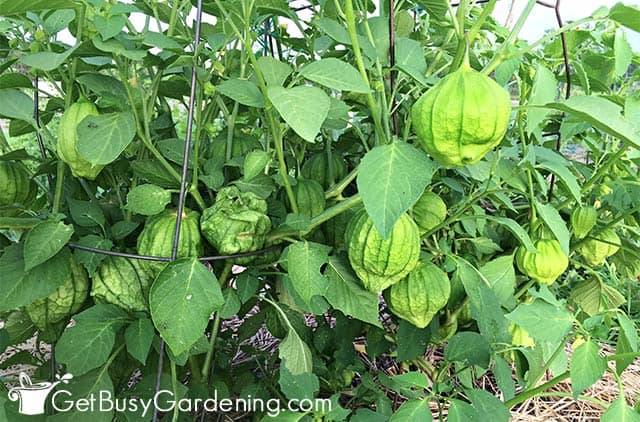
Tomatillo Plant Care & Growing Instructions
Now that you know when and where to grow tomatillo plants, it’s time to talk about how to care for them. Use the tips below to create their ideal environment.
Sunlight
It’s best to grow your tomatillos in full sun. They thrive in warm temperatures with lots of light. Too much shade can cause them to grow leggy and prevent them from flowering.
However, regular highs above 90°F (32°C) can slow down or even stop flowering and fruiting.
If you live in a very warm area, provide partial shade during the hottest part of the day. A shade cloth works great for this.
Water
It’s very important to keep your husk tomato plants evenly watered throughout the season by providing 1-1.5” of water a week.
They’re somewhat drought tolerant, but inconsistent watering can lead to issues like blossom end rot and cracking fruits.
Always water at the base of the plant to avoid moisture sitting on the leaves, as that can lead to mildew and disease issues.
Temperature
The best temperature range for growing tomatillos is between 60-85°F (16-29°C). They thrive in warm weather, but excesses regularly above 90°F (32°C) will stall flowering.
They are not cold tolerant at all. When temperatures fall below 55°F (13°C) flowering and fruit production will stop. Anything below freezing will damage and eventually kill the plant.
Fertilizer
While tomatillos are not heavy feeders, regular applications of fertilizer can help increase production.
Work organic slow-release granules into the soil once a month or apply a balanced liquid fertilizer, like compost tea or fish emulsion, every two weeks.
Avoid overdoing it or using high-nitrogen options, both of which will cause excessive foliage growth instead of fruit. A fertilizer with higher levels of phosphorus and potassium is ideal.

Soil
Tomatillos prefer well-drained, rich soil with a pH between 6.0-7.0, which you can test with a simple probe. But they aren’t too picky as long as they receive plenty of sun and water.
Amend garden soil with compost or worm castings during planting to promote drainage and increase the available nutrients.
Pruning
Regular pruning of your tomatillo plants isn’t necessary, but it does provide several benefits.
It promotes better air circulation, focuses energy on flowering and fruit production, and controls the size and shape of the plant.
Snip any suckers that form between the branches as they appear. You can also pinch back new growth when the plant reaches its ideal height, so it can focus on forming new flowers and ripening existing fruit.
Related Post: How To Freeze Tomatillos (With Or Without Blanching)
Pest Control Tips
Some of the most common pests for tomatillos include leafminers, cucumber beetles, aphids, flea beetles, slugs, snails, and potato beetles. And don’t forget microscopic pests like root knot nematodes.
You can hand pick large bugs and drop them into a bucket of soapy water to minimize insect damage. Using plant collars, traps, or sluggo pellets is also helpful in preventing slugs and snails.
Check the underside of leaves for eggs and remove any affected foliage immediately.
Sharp blasts of water and insecticidal soap are effective in controlling smaller pests like aphids and flea beetles. I make my own by mixing 1 teaspoon of gentle liquid soap with 1 liter of water.
Disease Control Tips
Tomatillos are fairly disease resistant, but they can be affected from time to time. Anthracnose, mosaic virus, powdery mildew, and blight are some of the more common ones.
If you see discolored black, brown, or yellow spots on the foliage or fruit, remove the affected parts immediately and destroy them to stop the spread. Don’t compost any diseased leaves.
Prune the plant to allow for better airflow, and try using an organic fungicide to slow the spread. In extreme cases, you’ll need to remove infected plants completely, not just the diseased portions.

Tips For Harvesting Tomatillos
Knowing when to pick them can be tricky for beginners. My guide on how to harvest tomatillos will walk you through everything in detail. But here are the basics.
Tomatillos fill out their papery husks when they’re approaching ripeness. Some fruits will turn a deep green or slightly yellow when they’re ready.
The husks usually begin to dry, turn brown and papery, and often split open when they’re ready to pick.
Clip the fruits from the branch with sharp sterile pruners, or gently twist them to see if they come free. Avoid tugging, which can damage the plant.
Related Post: How To Can Tomatillos

Troubleshooting Common Problems
Tomatillos are usually a highly productive plant in vegetable gardens, but learning how to grow them may take some practice. Here are some key tips on how to manage and correct some of the most common issues new gardeners face.
Small Fruits
Lack of pollination, high humidity, and temperatures above 90°F (21°C) can all cause small or undersized tomatillos.
Wind is not enough to properly pollinate the flowers, so be sure to attract plenty of bees to your garden to help them along, or do it by hand.
If temperature is too high or you’re experiencing a heat wave, provide some afternoon shade to keep them cool.
Flowers But No Fruits
Heat and lack of pollination are usually the cause of flowers that never form husks or set fruit.
You must have more than one tomatillo plant to get fruit, and you can easily hand pollinate the flowers between two or more plants.
If heat is consistently higher than 90°F (21°C) provide shade during the hottest part of the day, or protect them from the intense rays with a shade cloth.
Tomatillos Dropping From Plant
It’s not uncommon for tomatillos to drop from the plant when they’re ripe, or even slightly before.
As long as they’ve reached full size, collect them and allow them to finish ripening in their husks on the counter.
If your plant is dropping small, immature tomatillos, then it could be caused by drought, overwatering, bugs, disease, or lack of pollination.
Empty Husks
Empty husks are usually caused by certain environmental factors, such as excess heat, pollination issues, and lack of light.
Give them full sun, but protect them from high heat, bring pollinators into your garden, and always grow more than one plant.
If none of these seem to be the issue, be patient. Tomatillos can take a long time to fully mature, and it’s normal for large empty husks to develop well before the fruits do.
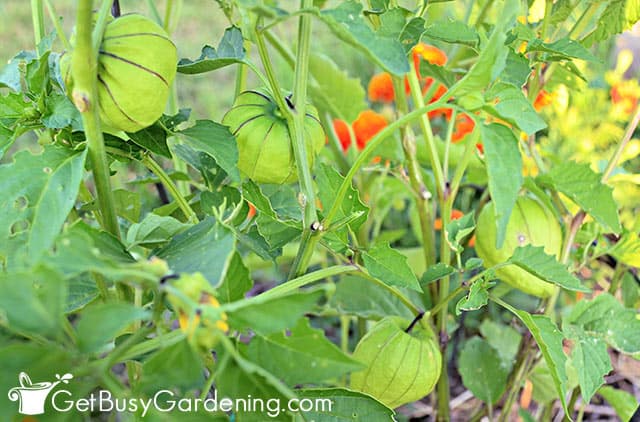
FAQs
Here I’ve answered some of the most commonly asked questions about growing tomatillos. If yours isn’t listed, please add it to the comments section below.
Are tomatillos easy to grow?
Tomatillos are easy to grow once you understand how to create their ideal environment and meet their needs. Provide plenty of direct sunlight, even and consistent water, and always grow more than one plant at once.
Do tomatillos grow back every year?
Tomatillos can grow back every year in zones 10-11. Although they are short-lived perennials, so most people end up replanting them every year for the biggest and best crops.
How long does a tomatillo plant last?
A tomatillo plant will last until it gets too cold for them, which is sometime in the fall for most climates. As soon as frost begins, the plant will stop producing and die. In warmer climates, they can live for more than one year.
Do tomatillos need 2 plants to fruit?
Yes, tomatillos need 2 plants so that they can cross-pollinate and set fruit.
Do tomatillos need a trellis?
Tomatillos don’t need a trellis to grow. But they do get very heavy with fruit, and will benefit from a support structure of some kind. This can be a trellis, stakes, or a plant cage, for example.
If you’d like to learn how to make the most of your space and get as much homegrown food as possible, then my Vertical Vegetables book is perfect! It will teach you all you need to know, has tons of gorgeous photos, and includes 23 DIY projects you can build for your own garden. Order your copy today!
Learn more about my Vertical Vegetables book here.
More About Vegetable Gardening
- How To Grow Okra
- How To Grow Cucamelons (Mouse Melon)
- How To Grow An Avocado Tree
- How To Grow Summer Squash
- How To Grow Kohlrabi
- How To Grow Passion Fruit
Share your tips for growing tomatillos in the comments section below.
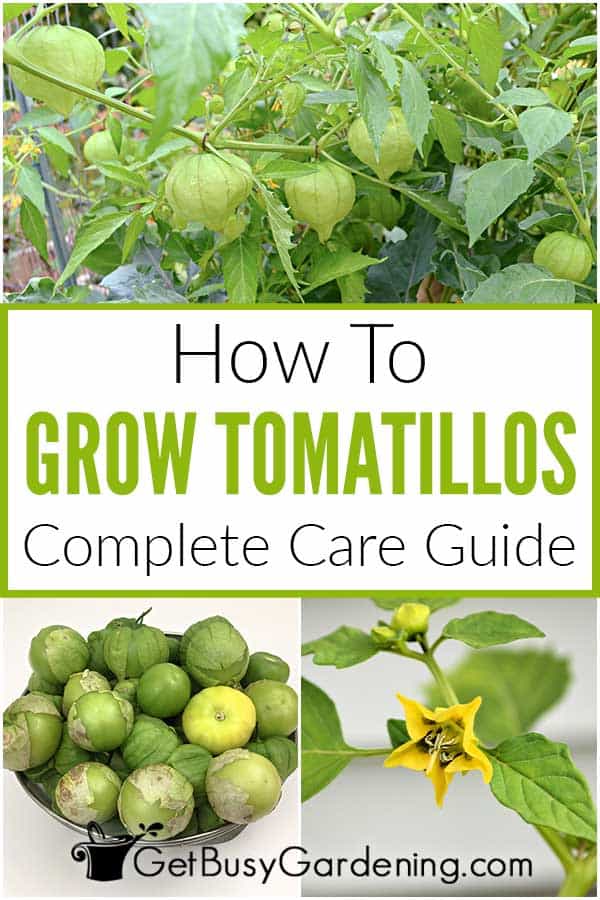
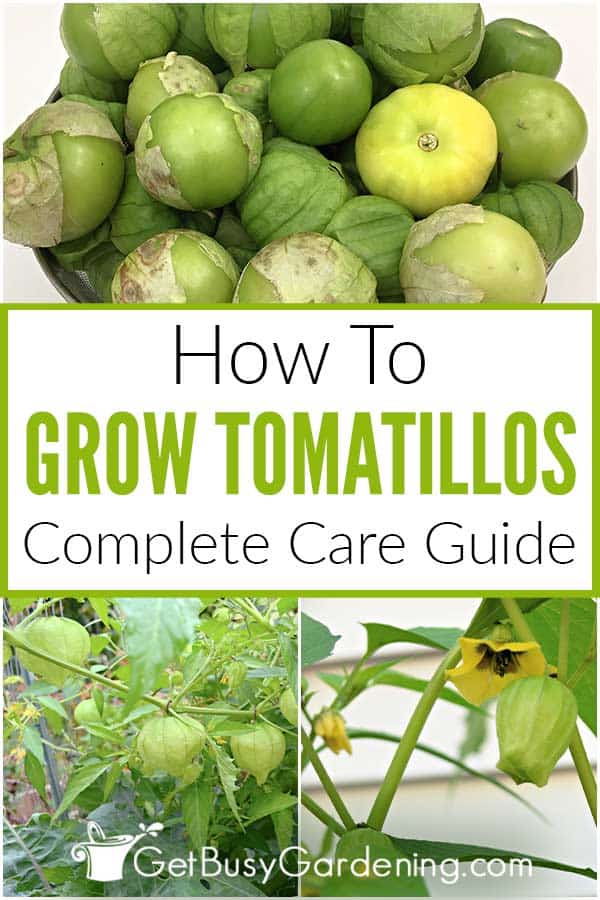
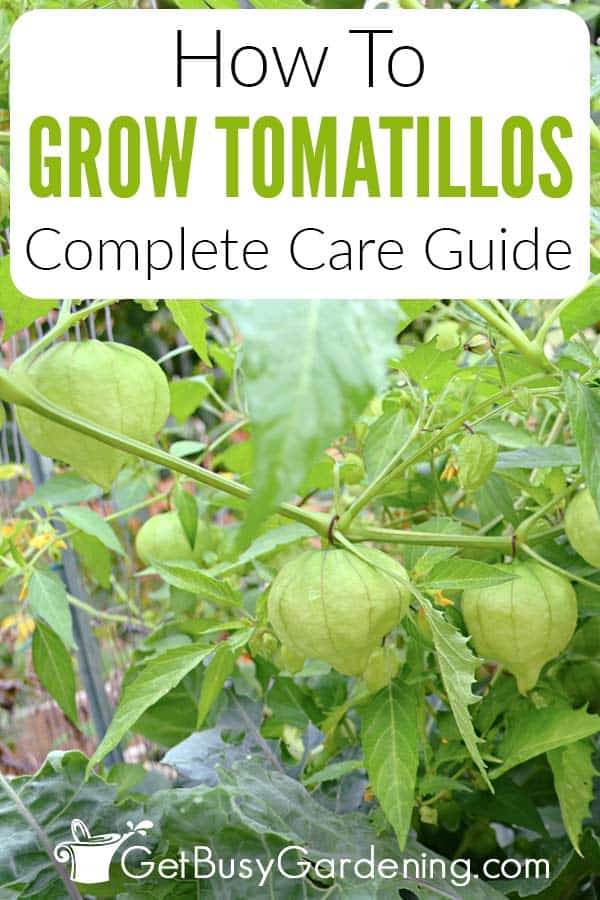




Catherine Kushner says
Hello,
I have never seen my question regarding tomatillos below addressed by anyone.
I was wondering since tomatillos require two plants to pollinate, if you can plant one of one variety and one of another variety?
Since I am not planning on saving seeds and have very limited space, I would love to be able to grow two different types.
Thanks so much,
Catherine
Amy Andrychowicz says
Yes, two different varieties of tomatillo plants can pollinate each other for setting fruit.
Carro says
Hi. Growing tomatillos for the first time. Have five plants. When in small pots on greenhouse table picked up pots and rubbed flowers together. One plant has paper cases forming. Now they are all in large pots can’t do that, so have been cross pollinating between plants with a chicken feather for several weeks. No new fruit have formed. They are in sunshine for most but not all of the day.
Amy Andrychowicz says
I would recommend using your finger to pollinate the tomatillo flowers, that will probably be more effective at transferring more of the pollen than using a feather. For best results, the plants should get at least 6 hours of full sun every day, so try to give them more if they’re getting too much shade.